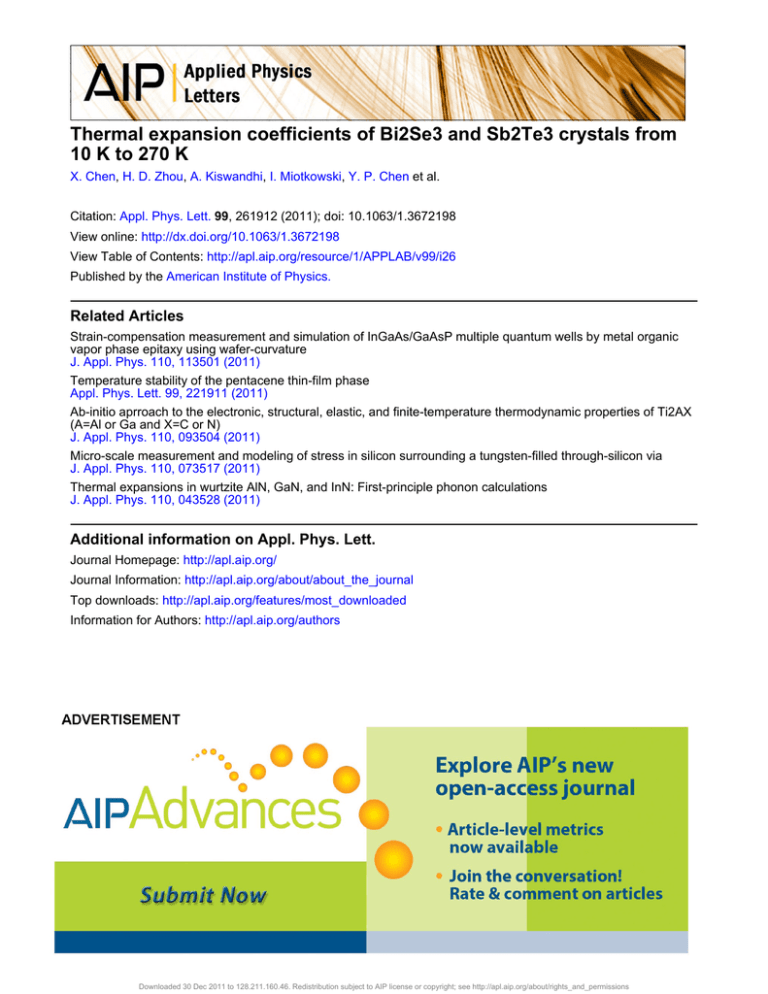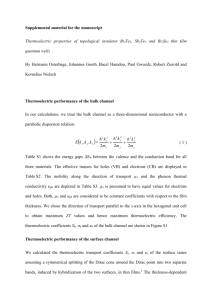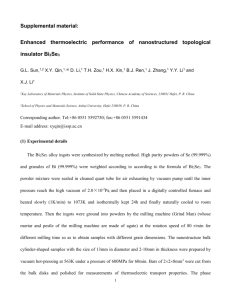Thermal expansion coefficients of Bi
advertisement

Thermal expansion coefficients of Bi2Se3 and Sb2Te3 crystals from 10 K to 270 K X. Chen, H. D. Zhou, A. Kiswandhi, I. Miotkowski, Y. P. Chen et al. Citation: Appl. Phys. Lett. 99, 261912 (2011); doi: 10.1063/1.3672198 View online: http://dx.doi.org/10.1063/1.3672198 View Table of Contents: http://apl.aip.org/resource/1/APPLAB/v99/i26 Published by the American Institute of Physics. Related Articles Strain-compensation measurement and simulation of InGaAs/GaAsP multiple quantum wells by metal organic vapor phase epitaxy using wafer-curvature J. Appl. Phys. 110, 113501 (2011) Temperature stability of the pentacene thin-film phase Appl. Phys. Lett. 99, 221911 (2011) Ab-initio aprroach to the electronic, structural, elastic, and finite-temperature thermodynamic properties of Ti2AX (A=Al or Ga and X=C or N) J. Appl. Phys. 110, 093504 (2011) Micro-scale measurement and modeling of stress in silicon surrounding a tungsten-filled through-silicon via J. Appl. Phys. 110, 073517 (2011) Thermal expansions in wurtzite AlN, GaN, and InN: First-principle phonon calculations J. Appl. Phys. 110, 043528 (2011) Additional information on Appl. Phys. Lett. Journal Homepage: http://apl.aip.org/ Journal Information: http://apl.aip.org/about/about_the_journal Top downloads: http://apl.aip.org/features/most_downloaded Information for Authors: http://apl.aip.org/authors Downloaded 30 Dec 2011 to 128.211.160.46. Redistribution subject to AIP license or copyright; see http://apl.aip.org/about/rights_and_permissions APPLIED PHYSICS LETTERS 99, 261912 (2011) Thermal expansion coefficients of Bi2Se3 and Sb2Te3 crystals from 10 K to 270 K X. Chen,1,a) H. D. Zhou,2 A. Kiswandhi,2 I. Miotkowski,3 Y. P. Chen,3 P. A. Sharma,4 A. L. Lima Sharma,4 M. A. Hekmaty,5 D. Smirnov,2 and Z. Jiang1,b) 1 School of Physics, Georgia Institute of Technology, Atlanta, Georgia 30332, USA National High Magnetic Field Laboratory, Tallahassee, Florida 32310, USA 3 Department of Physics, Purdue University, West Lafayette, Indiana 47907, USA 4 Sandia National Laboratories, Albuquerque, New Mexico 87185, USA 5 Sandia National Laboratories, Livermore, California 94550, USA 2 (Received 12 September 2011; accepted 27 November 2011; published online 30 December 2011) Lattice constant of Bi2Se3 and Sb2Te3 crystals is determined by x-ray powder diffraction measurement in a wide temperature range. Linear thermal expansion coefficients (a) of the crystals are extracted, and considerable anisotropy between ajj and a\ is observed. The low temperature values of a can be fit well by the Debye model, while an anomalous behavior at above 150 K is evidenced and C 2011 explained. Grüneisen parameters of the materials are also estimated at room temperature. V American Institute of Physics. [doi:10.1063/1.3672198] Recently, much attention has been given to an intriguing class of materials, the so-called topological insulators (TIs). This type of material exhibits a band gap in the bulk but gapless states on the edge or surface, which are protected by topological order and cannot be analogized to conventional semiconductors or insulators.1,2 Bi2Se3, Bi2Te3, and Sb2Te3 are among the most interested compounds of threedimensional TIs, owing to their robust and simple surface states.3 Although these compounds were under extensive studies in 1950s and 1960s as excellent thermoelectric materials, some basic physical properties still remain unexplored. In this letter, we present the measurements of the temperature dependent linear thermal expansion coefficients of Bi2Se3 and Sb2Te3 crystals using x-ray powder diffraction (XRD). Thermal expansion is the tendency of materials to change in size and shape as they heat and cool. It is essential to device design and engineering, as the induced strain could cause the deformation of the device and affect its phonon dynamics. Indeed, our recent Raman spectroscopy study of TIs has uncovered significant contributions in the temperature dependent phonon frequency shifts from the thermal expansion of the materials.4 In addition, the knowledge of thermal expansion coefficients is necessary for the directional growth of TI crystals and the understanding of the high thermoelectric efficiency.5 Large grain polycrystalline Bi2Se3 materials (single crystal grain size >1 mm) were synthesized at Sandia National Laboratories. First, Bi2Se3 pieces (99.999%, from VWR international, LLC.) were placed in an evacuated (<107 Torr) quartz ampoule and melted at 800 C for 16 h. The melt was then cooled at 10 C/h to 550 C, held for 3 days at this temperature, and finally allowed to furnace cool to room temperature. Single crystals of Sb2Te3 were grown by Bridgman method at Purdue University. Stoichiometric amount of high purity antimony and tellurium (99.999%) was deoxidized and purified by multiple vacuum distillations under dynamic vaca) Electronic mail: xcchen@gatech.edu. Electronic mail: zhigang.jiang@physics.gatech.edu. b) 0003-6951/2011/99(26)/261912/3/$30.00 uum of <107 Torr and then heated up to 900 C. This was followed by a slow cool down under a controlled pressure to minimize tellurium defects. Afterwards, the crystals were grown at a speed of 0.51.5 mm/h with a linear temperature gradient set to 5 C/cm. Bi2Se3 and Sb2Te3 crystals have similar rhombohedral structure with five atoms in the trigonal primitive cell. A straightforward way to visualize the structure is to use a hexagonal lattice with the unit cell being a quintuple layer, as shown in Fig. 1(a). Like graphite, adjacent Se-Se (Te-Te) layers are hold together by weak van der Waals force. The XRD patterns were recorded using a Huber G670 imaging-plate Guinier camera equipped with a Ge monochromator and Cu Ka1 radiation (1.54059 Å). Data were collected in steps of 0.005 in a wide temperature range from 10 K to 270 K. The lattice parameters were calculated via WINPREP program with residual factor 0.02 < Rw < 0.03. Typical XRD spectra of Bi2Se3 and Sb2Te3 crystals (at 10 K) are shown in Figs. 1(b) and 1(c), respectively. From the spectra, one can determine the lattice constant of Bi2Se3 (extrapolated to 0 K): ahex ¼ 4.1263 Å and chex ¼ 28.481 Å, which translate to arho ¼ 9.7880 Å and arho ¼ 24.337 for the rhombohedral cell. For Sb2Te3, the corresponding values are ahex ¼ 4.2423 Å, chex ¼ 30.191 Å, and arho ¼ 10.357 Å, arho ¼ 23.635 . Figure 2 plots the measured lattice parameters of Bi2Se3 and Sb2Te3 as a function of temperature, from which the linear thermal expansion coefficients (a) of the material can be derived aL ¼ 1 dL ; L dT (1) where L is the lattice constant (i.e., ahex or chex), and T is the temperature. Figure 3 shows the obtained linear thermal expansion coefficients of Bi2Se3 and Sb2Te3 parallel (ajj) and perpendicular (a\) to the trigonal c-axis. Considerable anisotropy between ajj and a\ is observed, reflective of the material bonding anisotropy. The ratio of the elastic constants C11/C13 characterizes the anisotropy of chemical bonds;C11/ 99, 261912-1 C 2011 American Institute of Physics V Downloaded 30 Dec 2011 to 128.211.160.46. Redistribution subject to AIP license or copyright; see http://apl.aip.org/about/rights_and_permissions 261912-2 Chen et al. Appl. Phys. Lett. 99, 261912 (2011) FIG. 1. (Color online) (a) Hexagonal unit cell of Bi2Se3. The distance between two nearest Se atoms of the two adjacent Se layers is larger than the sum of their covalent radii. As a result, the Se-Bi-Se-Bi-Se quintuple layers are hold together by weak van der Waals force. Bi2Te3 and Sb2Te3 have a similar structure by substituting Se atoms with Te, Bi atoms with Sb. Right panel: XRD spectra of (b) Bi2Se3 and (c) Sb2Te3 at 10 K. Maximum peak intensity is normalized to 1. C13 ¼ 2.5 for Bi2Te3 (Ref. 6) and similar values are expected for Bi2Se3 and Sb2Te3 owing to the structural similarity and comparable Debye temperature.7 To understand the temperature dependence of a(T), it is instructive to introduce the Grüneisen relation8 cv c ¼ jb; (2) where cv is the specific heat, c is the Grüneisen parameter, j is the bulk modulus, and b ¼ 2ajj þ a\ is the volumetric FIG. 3. (Color online) Linear thermal expansion coefficients of (a) Bi2Se3 and (b) Sb2Te3 as a function of temperature. Solid lines represent best fits using Debye model. The data well agree with the Debye T3 law at low temperatures, while considerable deviation is evidenced at above 150 K. thermal expansion coefficient. Usually, c and j are only weakly dependent on the temperature,9 indicating that the thermal expansion coefficient has the same temperature dependence as the specific heat. This relationship (a(T) vs. cv(T)) remains valid for anisotropic materials,10 therefore we can apply Debye model to fit our data a ¼ a0 FIG. 2. Lattice constant of (a) Bi2Se3 and (b) Sb2Te3 as a function of temperature. T HD 3 ð HD =T x4 ex dx 0 ðex 1Þ2 ; (3) where a0 is a temperature independent fitting parameter, and HD is the Debye temperature. Good agreement is achieved in the low temperature regime, as shown by the solid lines in Fig. 3, consistent with that observed in Bi2Te3.11 The obtained Debye temperature (from fitting both ajj and a\) is HD ¼ 160 K for Bi2Se3 and HD ¼ 200 K for Sb2Te3, close to the literature values (182 K and 160 K, respectively).6 At above 150 K, the experimental results deviate from the Debye model. Similar anomalous behavior is also evident in Bi2Te3,12 but the origin is not conclusive.11 There are two possible explanations: (1) This is due to higher-order anharmonic effects. Generally, the anharmonicity of the bonding forces in a crystal is characterized by the Grüneisen parameter. Higher-order anharmonic effects may lead to a nontrivial temperature dependence c(T), giving rise to anomalous ajj(T) and a\(T) through the Grüneisen relation. This scenario is used to explain the thermal expansion of tellurium13,14 and Bi2Te3.5 (2) The deviation could be due to the breaking of the van der Waals bond between two Se-Se (TeTe) layers, as proposed in Refs. 5 and 12 for Bi2Te3. The van der Waals binding energy is typically in the range of 0.4-4 Downloaded 30 Dec 2011 to 128.211.160.46. Redistribution subject to AIP license or copyright; see http://apl.aip.org/about/rights_and_permissions 261912-3 Chen et al. Appl. Phys. Lett. 99, 261912 (2011) TABLE I. Thermal expansion coefficients and Grüneisen parameters of Bi2Se3 and Sb2Te3 (at 270 K), and Bi2Te3 (at room temperature). ajj a\ b cp j (105 K1) (105 K1) (105 K1) (JK1 mol1) (GPa) c Bi2Se3 Sb2Te3 Bi2Te3 1.9 6 0.3 3.2 6 0.7 2.1a 1.1 6 0.1 1.8 6 0.6 1.4a 4.1 6.8 4.9 124.3a 128.8a 124.4d 48.4b 1.4 44.8c 2.3 37.4e 1.5e a See b See c See d See e Ref. 6. Ref. 16. Ref. 17. Ref. 18. See Ref. 7. 150 K. Our result is crucial for interpreting the temperature dependent Raman shift in Bi2Se3 and Sb2Te3 (Ref. 4) and may provide insight for understanding the thermal properties of TIs. We would like to thank S. Zhou for helping with the chemical structure in Fig. 1(a). This work is supported by the DOE (DE-FG02-07ER46451). The XRD measurement was performed at the National High Magnetic Field Laboratory, which is supported by NSF Cooperative Agreement No. DMR-0654118, by the State of Florida, and by the DOE. 1 kJ/mole, while the energy of thermal motion at room temperature is about 2.5 kJ/mole, suggesting that the degradation of the van der Waals bond may cause the anomaly in a(T) at levitated temperatures. These two reasons may also explain the differences in a(T) between Bi2Se3 and Sb2Te3, but further experimental and theoretical work is needed to fully understand it. Finally, we summarize the room temperature thermal expansion parameters of Bi2Se3, Sb2Te3, and Bi2Te3 in Table I, as a reference for future study of TIs and device engineering. The thermal expansion coefficients for Bi2Se3 and Sb2Te3 are taken from Fig. 3, which are in good agreement with the values documented in the materials handbook.6 Grüneisen parameters are calculated from Eq. (2). Specific heat at constant pressure (cp) of the materials is better documented in the literature, and thus used in the calculation.15 For Bi2Te3, the values are extracted from various previous works. In conclusion, we have measured the thermal expansion parameters of Bi2Se3 and Sb2Te3 crystals in a wide temperature range from 10 K to 270 K. The extracted linear thermal expansion coefficients are found in consistent with the Debye model at low temperatures, but deviate at above M. Z. Hasan and C. L. Kane, Rev. Mod. Phys. 82, 3045 (2010). X.-L. Qi and S.-C. Zhang, Rev. Mod. Phys. 83, 1057 (2011). 3 H. Zhang, C.-X. Liu, X.-L. Qi, X. Dai, Z. Fang, and S.-C. Zhang, Nat. Phys. 5, 438 (2009). 4 Y. Kim, X. Chen, Z. Wang, J. Shi, I. Miotkowski, Y. P. Chen, P. A. Sharma, A. L. Lima Sharma, M. A. Hekmaty, Z. Jiang et al., e-print arXiv:1112.1364. 5 L. M. Pavlova, Yu. I. Shtern, and R. E. Mironov, High Temperature 49, 369 (2011). 6 O. Madelung, Semiconductors: Data Handbook, 3rd ed. (Springer, Berlin, 2004). 7 J. O. Jenkins, J. A. Rayne, and R. W. Ure, Jr., Phys. Rev. B 5, 3171 (1972). 8 E. Grüneisen, Ann. Phys. 39, 257 (1912); Handb. Phys. 10, 1 (1926). 9 N. W. Ashcroft and N. D. Mermin, Solid State Physics (Brooks/Cole, Thomson Learning, Cornell, 1976). 10 C. L. Choy, S. P. Wong, and K. Young, Phys. Rev. B 29, 1741 (1984). 11 J. O. Barnes, J. A. Rayne, and R. W. Ure, Phys. Lett. A 46, 317 (1974). 12 M. H. Francombe, Br. J. Appl. Phys. 9, 415 (1958). 13 H. Ibach and R. Ruin, Phys. Status Solidi 41, 719 (1970). 14 T. G. Gibbons, Phys. Rev. B 7, 1410 (1973). 15 The difference between cp and cv is negligible (Ref. 16), compared with the uncertainty of our measurements. 16 G. E. Shoemake, J. A. Rayne, and R. W. Ure, Phys. Rev. 185, 1046 (1969). 17 O. Kim, K. Lee, S. Han, G. Ha, D. Kim, and W. Yoon, in Proceeding of the 24th International Conference on Thermoelectrics (IEEE, Piscataway, NJ, 2005), pp. 319–322. 18 K. C. Mills, Thermodynamic Data for Inorganic Sulphides, Selenides and Tellurides (Butterworth, London, 1974). 2 Downloaded 30 Dec 2011 to 128.211.160.46. Redistribution subject to AIP license or copyright; see http://apl.aip.org/about/rights_and_permissions



